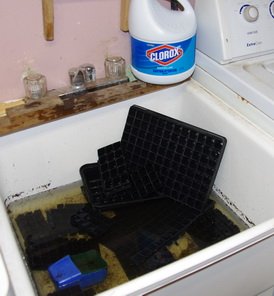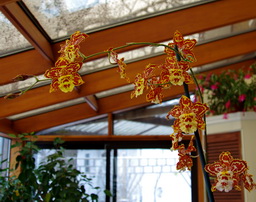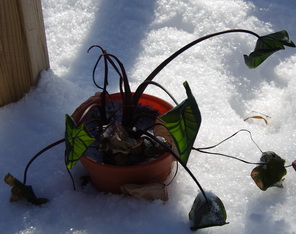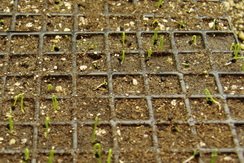


I have had a great holiday from writing and sort of a holiday from gardening but it’s time to get back into the world of green growing things and talking to you, my readers, about it. A dedicated, or possibly addicted, gardener never really stops. I created the opportunity to plant a few Amaryllis bulbs with some of my grandchildren over the holidays. They all seem to enjoy it, even the two year old who loved Dallying In The Dirt. The older ones are already sending me pictures of the big blooms that they have managed to grow. It’s a great way to get kids interested and excited about gardening. Easy to plant; grows fast; amazing results.  A little tune up to the germination area will help with my success rate. The fluorescent tubes need a little attention. We need to, at least, clean them so last years dust and dirt doesn’t stop all of the light from reaching our seedlings. These tubes also diminish in power over time and they should be replaced every couple of years even though they are still apparently working. This year, for sure, I’m going to put the date on each new tube so that I can tell how long it has been in service. Just trying to remember doesn’t seem to work anymore. I will also plug in my heating cables to make sure that they are working. Getting the soil in the germination trays warm, is one of the most important things we can do to ensure success. All of the trays and tools will be well washed and bleached in order to try and prevent the arrival of a terrible fungus disease Damping Off that can wipe out a tray of seedlings in a couple of days. By the time you notice it, it’s too late to do anything about it. Several people have told me that ground cinnamon is an effective preventative and I think I will test that theory this year. Of course, if no damage occurs, can we be sure it was the cinnamon or the cleanliness measures that worked. I have neither the space nor the spare seeds to run a control for this experiment.
A little tune up to the germination area will help with my success rate. The fluorescent tubes need a little attention. We need to, at least, clean them so last years dust and dirt doesn’t stop all of the light from reaching our seedlings. These tubes also diminish in power over time and they should be replaced every couple of years even though they are still apparently working. This year, for sure, I’m going to put the date on each new tube so that I can tell how long it has been in service. Just trying to remember doesn’t seem to work anymore. I will also plug in my heating cables to make sure that they are working. Getting the soil in the germination trays warm, is one of the most important things we can do to ensure success. All of the trays and tools will be well washed and bleached in order to try and prevent the arrival of a terrible fungus disease Damping Off that can wipe out a tray of seedlings in a couple of days. By the time you notice it, it’s too late to do anything about it. Several people have told me that ground cinnamon is an effective preventative and I think I will test that theory this year. Of course, if no damage occurs, can we be sure it was the cinnamon or the cleanliness measures that worked. I have neither the space nor the spare seeds to run a control for this experiment.  Upstairs, in the solarium, my growing collection of Orchids is starting to put out quite an array of gorgeous blooms. I acquired a new Oncidium last year because it had some great gold and maroon speckled flowers. I was happy just to watch those blooms open. It is now putting up four new bloom stalks and they have opened about twenty blooms so far with many more to come. The Cymbidium Orchids, that summer outside in the bright sun, are rewarding me for that time by throwing several bloom stalks that should open up in the next few days and they usually last for about three months. The last of the blooms is usually hanging on when they move outside again in late May. They are large, rather unattractive plants, when they are not blooming but they make up for it when that mass of 7 - 8 cm blooms brightens our winter days.
Upstairs, in the solarium, my growing collection of Orchids is starting to put out quite an array of gorgeous blooms. I acquired a new Oncidium last year because it had some great gold and maroon speckled flowers. I was happy just to watch those blooms open. It is now putting up four new bloom stalks and they have opened about twenty blooms so far with many more to come. The Cymbidium Orchids, that summer outside in the bright sun, are rewarding me for that time by throwing several bloom stalks that should open up in the next few days and they usually last for about three months. The last of the blooms is usually hanging on when they move outside again in late May. They are large, rather unattractive plants, when they are not blooming but they make up for it when that mass of 7 - 8 cm blooms brightens our winter days. I had a small, rather pretty, Colocasia overwintering on the windowsill of the solarium. It was a sample from somewhere and had no special significance to me. This week I noticed the leaves looking poorly and upon close inspection found a nice population of Spider Mites developing on it. These horrible, difficult to control, pests of many indoor plants have no place in my house and I solved the problem by putting the whole pot outside in a nice snow drift. Plant and mites are no longer with us and hopefully they had not spread to other plants. I will be watching closely because they were very close to the Cymbidiums. Fortunately the tough, coarse foliage of these Orchids are not usually attractive to spider mites.
I had a small, rather pretty, Colocasia overwintering on the windowsill of the solarium. It was a sample from somewhere and had no special significance to me. This week I noticed the leaves looking poorly and upon close inspection found a nice population of Spider Mites developing on it. These horrible, difficult to control, pests of many indoor plants have no place in my house and I solved the problem by putting the whole pot outside in a nice snow drift. Plant and mites are no longer with us and hopefully they had not spread to other plants. I will be watching closely because they were very close to the Cymbidiums. Fortunately the tough, coarse foliage of these Orchids are not usually attractive to spider mites.Time to answer a few questions. If you have a gardening question just ‘reply’ to this newsletter and send me your query. I try to answer most of the questions and the ones that I answer here are those that I think will have the widest interest. You can also find the latest garden updates on the front page of gardening-enjoyed.com . Linda Asks ? I have a rose bush that hasn't bloomed in a very long time. It's leaves are the healthiest looking of any of my Roses', I have tried cutting it back in the fall, I have tried leaving it until spring and then cutting it back to the new growth, I have fertilized, I even put coffee grounds (at someone's suggestion) around the plant. Do you have any idea why it hasn't bloomed. I want to remove it because it doesn't produce any flowers, but it it so healthy looking other wise, that I don't want to get rid of it. HELP! Ken Answers Since it is growing so well, I suspect that the Rose that you originally purchased, died some time ago and the root stock that it was grafted to, is what is now thriving in your garden. Although the root stock plant is capable of some sort of blooms it apparently is not going to do that in your conditions. Do the leaves have more and smaller leaflets than your blooming roses? 111 Trent St. W. Whitby ON L1N1L9 |
 It’s now time for getting some of the early seeds
It’s now time for getting some of the early seeds 